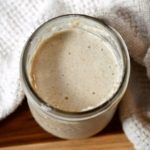Gluten-Free Sourdough Starter
Learn how to make a gluten-free sourdough starter from scratch! It’s the secret to amazing gluten-free bread, as it improves taste and the texture. Use your favorite flour: rice, oat, teff, sorghum, or buckwheat!
- Prep Time: 5 minutes
- Total Time: 5 minutes
- Yield: 1/4 cup 1x
- Category: Bread
- Method: Sourdough
- Diet: Gluten Free
Ingredients
Units
Scale
- 1/4 cup whole-grain gluten-free flour (see the section above for details on each type of flour)
- 3 Tbsp filtered water (do not use chlorinated tap water)
Instructions
- Add equal parts of water and flour into a glass container. This could be 1 Tbsp of flour and water, or 1 cup of flour and water. It really depends on how much starter you need.
- Mix the flour and water with a fork. Try to bring air into the flour to help with fermentation. Cover the container with a tea towel and leave it to ferment at room temperature (your kitchen counter is perfect).
- Stir with a fork twice a day until it has started to sour. The starter is ready when it smells slightly sour and has some bubbles. Depending on the type of flour you use it can take 2-7 days.
- There’s no need to feed the starter until it has started to bubble. Once it is bubbling, you will need to feed it half of its volume of water and flour. There are a few factors that influence how often you need to feed your starter. See the section above for detailed information on how to feed your starter for continuous baking.
Notes
- The ratio of flour and water is approximate. For example, buckwheat, oat and white rice absorb more water. Brown rice and teff absorb less water. Adjust the recipe so that you have a thick, yet still pourable consistency. It doesn’t have to be exact and you can adjust the flour/water ratio as you feed your starter. See the video above which shows the consistency you’re looking for.
- Most of my recipes start with 1-2 cups of active sourdough starter, so I recommend making a large amount of starter and keeping it going.
- I recommend using a gluten-free bread flour mix for gluten-free loaves, however, don’t use it for your starter. Just use wholegrain flour or white rice flour for your starter as the will feed the bacteria and yeast.
